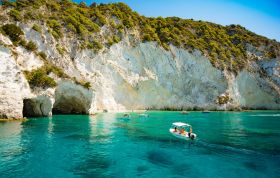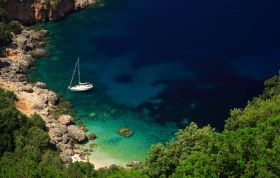From Kefalonia, by boat, the beautiful coastline and the picturesque islands nearby are literally at your feet.
Every day, small yachts and sailing boats depart from various points on the island for daily organized excursions to destinations like Ithaca and all of the beaches only accessible by boat. At "Skinos Ilivatos Eco Villa and Estate" in cooperation with well-trained partners, have designed our own trip, a sea quest that has its roots in Greek mythology.
The phrase "Skinos Ilivatos" comes from Homer’s epic poems, Iliad and Odyssey, and it means"a high, inaccessible place that only the sun can reach".
A harbor is the beginning and the end of a journey. That’s why we have our harbor, a small dock (similar to the one in the Homeric poem),environmentally friendly (wooden) that does not pollute the environment. This dock is the starting point of our sea excursion in which every visitor feels like a small Odysseus.
Small sailing boats take visitors to secluded beaches, like Vatsa (temple of Poseidon), or to see the light house of Gero-Gompos. The “sweet Odyssey” has just begun.
The cruise is routed on the same sea lanes where Agamemnon and Menelaus along with Ulysses started their journey to the most glorious quest of all time.
After a while, passengers are able to see Athera, the first coast of Ithaca, where according to Homer the ship that was carrying Telemachus arrived from Pylos.
Leave behind the cape of Gero Gompo admiring the lighthouse that has been standing there for decades, leading men safely to the open sea.
The second stop of our journey is the location of Petani, a famous tourist resort. The name of the resort came from the change of the word EΠΗETANOI (OD. ν 247) over the years. The meaning of this word is “someone or something that is constant through years, rich, plenty”.
We will have the opportunity to dive into the clear blue waters and then we will continue towards the Homeric harbor of Forkyna (Atheras).
This is the port where Ulysses was brought to by the Feakes from Scheria (Corfu). The historic port - which Ulysses, the king of Ithaca, returned after his wanderings - got its name from the ancient God Forkyna.
An olive tree - exactly in the same place where the poet describes it - is still here at the harbor, at the edge of the beach. Under this olive tree gifts were placed by the Feakes people. Later, underneath sacred olive’s shade, the king of Ithaca and Pallas Athena (OD. ν 372) sat together.
We will make a stop for lunch underneath the same shade and then we’ll follow the path to the cave of the Nymphs, the entrance of which is located at the port of Athera, close to Saint Spyridon church.
The elders used to scare naughty children by saying they will abandon them at the cave of Odysseus.
We return to the port and head towards the South.
Next stop is the “Simpligades” (moving rocks) of Lixouri ("Planktas kaleousi” (OD. μ 61)).
The famous "Kounopetra", in the south Palliki, is a natural phenomenon which Homer pointed out in the Odyssey’s verses. This means that he knew about the uniqueness of this phenomenon. We will get closer and take a look at the perpetual motion and collision of these two rocks.
Our sea quest continues with a tour at Livadi of Palliki, a place that matches the Homeric "Asfodelon Leimona”. The deep bay, the bog, the surrounding area and the small village, are all called Livadi.
Next, we will feel a little bit like the “Porthmies”, the ferrymen who were transferring goods from the coast of Palliki to the coast of the municipality of Kefalonians (Argostoli - Thinia).
After that we will visit Argostoli and the last stop on our way home will be the "Charybdis” of Argostoli.
According to Kirki, Ulysses, during his returning to Ithaka, had to sail through a place where at the one side were the “Simpligades” (OD. μ 61), the moving rocks, and on the other side were two reefs (OD. μ 73). On one of the two reefs was the Scylla and on the other was the terrible Charybdis who swallows (OD. μ 104) the sea water.
The geological phenomenon of Charybdis that swallows the sea water is actually the Katavothres of Argostoli. We will observe this geological phenomenon and then we will sail back to our picturesque harbor.




